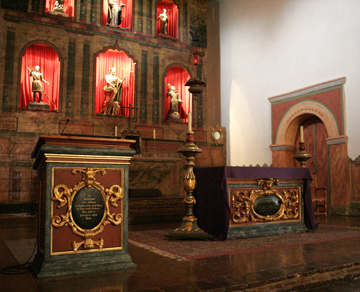
Mission community comes together to create a work of art
Faith is the basis of things hoped for, and certainty in what
cannot be seen.
During Mission San Juan Bautista’s bicentennial in 1997, Father
Ed Fitz-Henry, the mission’s pastor, looked at the beautiful altar
given to his church as part of the celebration. It was the perfect
complement to the mission’s adobe walls, the reredos (the
decorative facing on the wall at the back of the altar) which holds
statues of six Catholic saints and the handmade floor tiles. But
one thing was amiss
– the ambo.
Mission community comes together to create a work of art
Faith is the basis of things hoped for, and certainty in what cannot be seen.
During Mission San Juan Bautista’s bicentennial in 1997, Father Ed Fitz-Henry, the mission’s pastor, looked at the beautiful altar given to his church as part of the celebration. It was the perfect complement to the mission’s adobe walls, the reredos (the decorative facing on the wall at the back of the altar) which holds statues of six Catholic saints and the handmade floor tiles. But one thing was amiss – the ambo.
Ambo, a word of Greek origin, means mountain or elevation. In the Catholic Church, an ambo is the podium from which the readings and gospels are read during Mass. And while San Juan’s ambo was nice, it no longer fit in with the decor of the renovated mission.
“We had this beautiful new altar, and we didn’t have anything to match it,” Father Ed said. “We had a podium, but it was now inappropriate. It was flimsy. I mentioned that it would be nice if we could have a new ambo.”
Fr. Ed hoped for a new ambo, and believed it could happen, even if he couldn’t see how. His prayers for the ambo were soon answered by a parish community willing to do what they needed to make it happen.
There was Keith Wright, a local cabinet maker, who told Fr. Ed he believed he could make an ambo and find a way to match the existing altar’s design. Wright enlisted the help of his uncle, Edgar Corey, to carve scrollwork for the front of the ambo. Local artist Charlie Cincone painted the ambo to match the altar, using gold leaf for the scrollwork. A friend of Wright’s donated the money to pay for the work. And finally, local resident Ron Olmstead documented the project’s history in written form.
“This was a labor of faith, hope and love,” Fr. Ed said. “We are all delighted with the project.”
Mission San Juan Bautista was founded in 1797, and the mission church was completed in 1812. It has many unique features, such as the reredos painted by American sailor Thomas Doak in exchange for room and board, the tile flooring with the tracks of wild animals who walked in through the clay as the tiles were drying and the three naves (aisles) which make San Juan Bautista the largest church in the California mission chain.
The church was renovated in time for its bicentennial, and one of the gifts the church received was a new altar. Over the years, many different altars had graced the front of the church, but this one was special. It was built in sections, and the front part, which features a large oval medallion with the words Jesus Christ spoke to his 12 disciples during the last supper painted in Latin – “This is my body, given up for you. Do this in remembrance of me” – was built in Spain in the 1600s. It was used first at Mission San Fernando, and later at Mission Carmel, before coming to San Juan Bautista in 1997.
“Father Ed asked in passing, ‘How can we obtain an ambo for the mission?’ A local San Juan Bautista master cabinet maker declared he could create an ambo and suggested he could match the existing mission altar motif,” Olmstead wrote. “Keith Wright…offered to donate his time and creative skills for the project and, as he always does, began to envision a design and come up with some unique plans for implementing the project.”
Fr. Ed and Wright worked together to finalize the plans for the ambo, and once that was done, Wright went to work. The first step was to find the wood he would need for the project.
“Wright wondered if there might be remnants of wood around the mission that could be incorporated into the ambo,” Olmstead wrote. “They (Wright and Fr. Ed) undertook a search of the buildings and grounds. While in the choir balcony, they could see through a small crack in the wall across to a loft area above the mission store where there appeared to be some lumber in the form of beams. Upon further investigation, they determined these were old redwood beams, covered with dust from years of idle storage. Other sources…were found, including an old door and a flooring plank.”
Wright sawed the beams to create planks and trim for the ambo, and he used the hand-carved trim from the door along the ambo’s base. He took pictures of the altar so he could duplicate the patterns onto the ambo. He sent some of the redwood and the pictures to his uncle, Edgar Corey, a woodworker who lived in Vermont. Corey used the photos to carve matching scrollwork out of the redwood.
After receiving the finished scrollwork, Wright finished assembling the ambo in his Mission Street workshop. The next step was the painting of the ambo, and Fr. Ed knew just who he wanted to do the work.
“The finishing on the ambo was the work of another local master craftsman and artist, Charlie Cincone, who Fr. Ed brought to the project, and who had in the past done restorative work in the mission,” Olmstead wrote. “He did all the painting and gold leaf on the ambo, and a masterful job of matching the motif of the altar.”
Wright had duplicated the oval medallion of the altar onto the ambo. Fr. Ed asked Cincone to paint on the front of the oval the first words of the gospel of St. John – “In the beginning was the Word, and the Word was with God, and the Word was God.” Cincone asked a parishioner who knew Latin to translate for him, and the Latin words now grace the ambo.
The parishioners were kept up-to-date on the project, and watched as the artists completed each different step in the process, Fr. Ed said.
“This project came together in a miraculous fashion, and to be able to reveal it to the parishioners in a gradual way was really kind of cool,” he said. “We kind of finished off our bicentennial celebration with the completion of the ambo.”
The ambo was unveiled in 2003, and a few years later, Olmstead was having lunch with Wright at J.J.’s Burgers. Wright told him the story about the ambo, and Olmstead asked if he could write down the project’s history. He spoke with Fr. Ed about the mission’s history, and Wright and Cincone about the project. Today, his written account has received Fr. Ed’s blessing, and includes additional history about the redwood used to build the ambo.
“It’s really amazing,” Olmstead said of the ambo that now sits next to the altar in the mission church. “These two items were built 200 years apart, but they look like they could have been built at the same time.”









